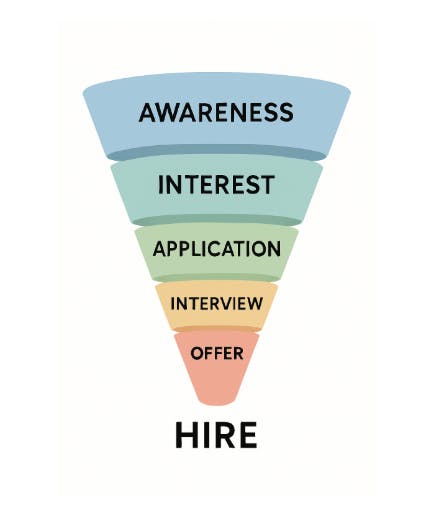Funnel-ly enough…
Recruitment seems a straightforward enough process. You start with lots of applicants. You boil them down to a handful of interviewees. You offer to one person.
That’s a talent acquisition funnel.
Though, funnel’s kind of a misnomer. In a physical funnel, everything eventually gets through. But the funnel approach in HR is like pipeline-style funnels in sales and marketing – taking a broad group and filtering out the unsuitable in a controlled way, so all that’s left are your buyers (or, in recruitment, hires).
A simple narrowing-down exercise – many to few.
The issue is: many companies think they’re entirely in control of that reduction. But there’s always leaks in the funnel, even in the very best recruitment processes. Leaks, here, are potentially suitable candidates removing themselves from the process voluntarily.
50% of companies have lost candidates at interview stage due to poor interview processes.1 Almost half the candidates who drop out do so during interview and assessment.1
Leaking candidates limits your talent pool and could result in elongated recruitment campaigns, which can cost you time and money.
Sure, some are unavoidable. Others you can mitigate. And you start by diagnosing your recruitment funnel.
Table of Contents
- What is a Recruiting Funnel?
- Key Benchmarks for a Healthy Hiring Funnel
- Characteristics of a Healthy Recruiting Funnel
- Analyzing and Evaluating Funnel Health
What is a Recruiting Funnel?
If you’re asking, “How do I build a recruitment funnel?” or “Where can I buy one?”, never fear. They’re a naturally occurring by-product of virtually all recruitment activity (besides just hiring someone you know on the spot).
So we’re all on the same page, here’s a recruitment funnel example:

Awareness
What it is: This is the top of the funnel in recruitment. The stage at which potential applicants discover you have a vacancy. It usually takes the form of a job advert, but could also include outreach – directly contacting potential applicants about jobs.
What can go wrong: Besides speculative applications, if no-one knows you’re hiring, you won’t have any applicants.
Interest
What it is: Interest describes a candidate deciding to apply. It typically happens as a byproduct of them reading the job advert or having a preliminary call about the opportunity.
What can go wrong: If your job advert is too long or boring, people may be aware you’re hiring, but they won’t read enough to be interested. If you don’t give candidates a reason to apply and don’t sell the opportunity based on their needs, they won’t bother.
Application
What it is: The actual process of applying. Typically, this involves a candidate sending a CV and having it screened by the hiring manager or recruiter.
What can go wrong: Is your application process arduous? Does it involve candidates signing up to something, typing out information that’s available on their CV, or asking them to complete long tasks? If so, potential applicants may not make the effort. And if you’re not 100% sure what you’re looking for on a CV, you may end up rejecting suitable candidates or promoting unsuitable ones.
Interview
What it is: What it says on the tin – the interview stage. The hiring company learns about the candidate and sells the opportunity, and the candidate learns about the opportunity and sells themselves.
What can go wrong: The leakiest area of the hiring funnel, where most dropouts occur. The bulk of the issues are the process being too long or involving too many interviews1, meaning candidates walk away or accept faster-moving offers.
Offer
What it is: After deciding to hire applicants, this is where you offer them the job. You present their salary, role details, and likely a contract of employment.
What can go wrong: If you haven’t gauged the candidate’s needs or whether you have any competition for their signature, there’s no guarantee they’ll accept your offer. You also have to be wary of them being counter-offered by their current company.
Hire is the final stage, and it overlaps with onboarding. There’s still nurturing a recruiter might need to do to ensure the hire’s there on their first day, but they’re largely out of your funnel by this point.
Key Benchmarks for a Healthy Hiring Funnel
That’s your recruitment funnel template. Now, how can you tell if it’s working?
You need to establish some recruitment funnel metrics. They function much like other Recruitment Metrics, only they apply specifically to your hiring funnel.
And it makes sense to measure this data. Hiring teams with solid data analytics are twice as likely to improve their recruiting efforts and 3X more likely to reduce recruiting costs.2
But what should you measure?
Well, here’s a recruitment funnel template that shows where candidates typically drop out:

Notably, there’s no drop-off from awareness to interest because it’s difficult to measure. You can’t really know how many people are aware you’re hiring versus how many of those become interested in applying.
One thing you can measure is your conversion. Assess how many candidates reach each stage. That way, you’ll be able to see whether they line up with these averages.
If they don’t, why not? Tracking the reasons candidates drop out gives you a more complete picture. How many were your decision? How many were the candidate’s? What could you do to reduce attrition?
You could also measure things like:
- Time-to-hire: The global average time-to-hire is around 44 days, although it varies by industry.3 You should measure how long it takes from a role going live to it being filled. If you can’t beat 44 days, ask yourself why.
- Cost-per-hire: Cost per hire will vary dramatically based on industry, seniority, location, and other factors. But as we discussed at the start, it’ll be higher if you have a lot of candidate attrition. Measure it, and see if a less leaky funnel brings it down.
- Candidate Satisfaction: If a candidate has a positive experience during the interview process, they’re more likely to stick around for an offer (around 70%). If they have a negative experience, it drops to as low as 20%.4 Besides increasing the likelihood of hire, measuring your application experience satisfaction at each stage can help you see where things are going wrong. The global average satisfaction is about 75%5, so you should be aiming to beat this.
- Diversity and inclusion: If you’re tracking applicants by their identity characteristics, measure drop-out rates at each stage by group. If members of one group seem to be disproportionately more likely to leave at a given level, ask yourself why. Could you make things more accessible?
Analyzing and Evaluating Funnel Health
Now you have an idea where your recruitment funnel should be. How exactly do you diagnose it?
Your Data-Driven Recruitment Strategies will depend on your recruitment set-up, but you could try:
Using your ATS to spot bottlenecks
An Applicant Tracking System, or ATS, is software that tracks candidates’ journeys through your hiring process, and can display it on a recruitment funnel dashboard. The best ones have a means of measuring and registering data like candidate source, reasons for rejection, satisfaction, and so on. It’s your first port of call for staying on top of your hiring funnel metrics. You can often set up alerts if any of your metrics drop below your benchmarks, and act accordingly.
Using feedback loops
If distinct recruitment functions (CV screening, interviewing, onboarding, etc.) are done by different people, ensure there’s communication about the hiring journey. What do the onboarders know about candidate experience they can tell conducting interviewers? What can CV screeners tell the job advertisers about the requirements? You can often log these insights in an ATS. Make sure your recruitment team’s unified.
Regular evaluations
If you’re happy with your metrics in Q1, don’t assume they’ll still be good in Q4. Things can change quickly. Checking your funnel regularly means you can improve small issues with quick tweaks, rather than big problems with costly overhauls.
What If My Funnel’s Sick?
If your metrics aren’t where you want them to be, don’t panic.
Arguably, while there’ll always be some unavoidable drop-outs (catching people at the wrong time, the role simply not being right for them, etc.), there are always methods of reducing your candidate attrition.
For example, did you know your application rate drops by half if you ask too many questions at application stage, or by almost 4X if it takes more than 15 minutes?6
Luckily, by measuring your hiring funnel, you at least know where the problems are.
How you keep your funnel healthy is up to you.
Want advice? Speak to Remote Crew about leakproofing your hiring funnel.
1: Laurano, M. Key Trends in Interviewing, 2022. Aptitude Research. Accessed 17th June 2025.
2: Cruz, E. L. Data Driven Recruiting, 2015. [PDF] LinkedIn Talent Solutions. Accessed 19th June 2025.
3: New research shows that hiring is harder than ever: Time to hire increasing significantly for almost all roles, 2023. AMS. Accessed 18th June 2025.
4: Ibukunoluwa, O. Predicting Job Interview Outcomes Using Glassdoor Reviews, 2019. Medium. Accessed 19th June 2025.
5: GRID 2024 Talent Trends Report, 2024. Bullhorn. Accessed 19th June 2025.
6 Forman, C. Transform Your Recruiting Strategy By Taking a Look at the Numbers, 2015. Recruiter.com. Accessed 18th June 2025.
Tech hiring insights in your inbox
From engineers to engineers: helping founders and engineering leaders hire technical talent.
We will only ever send you relevant content. Unsubscribe anytime.







